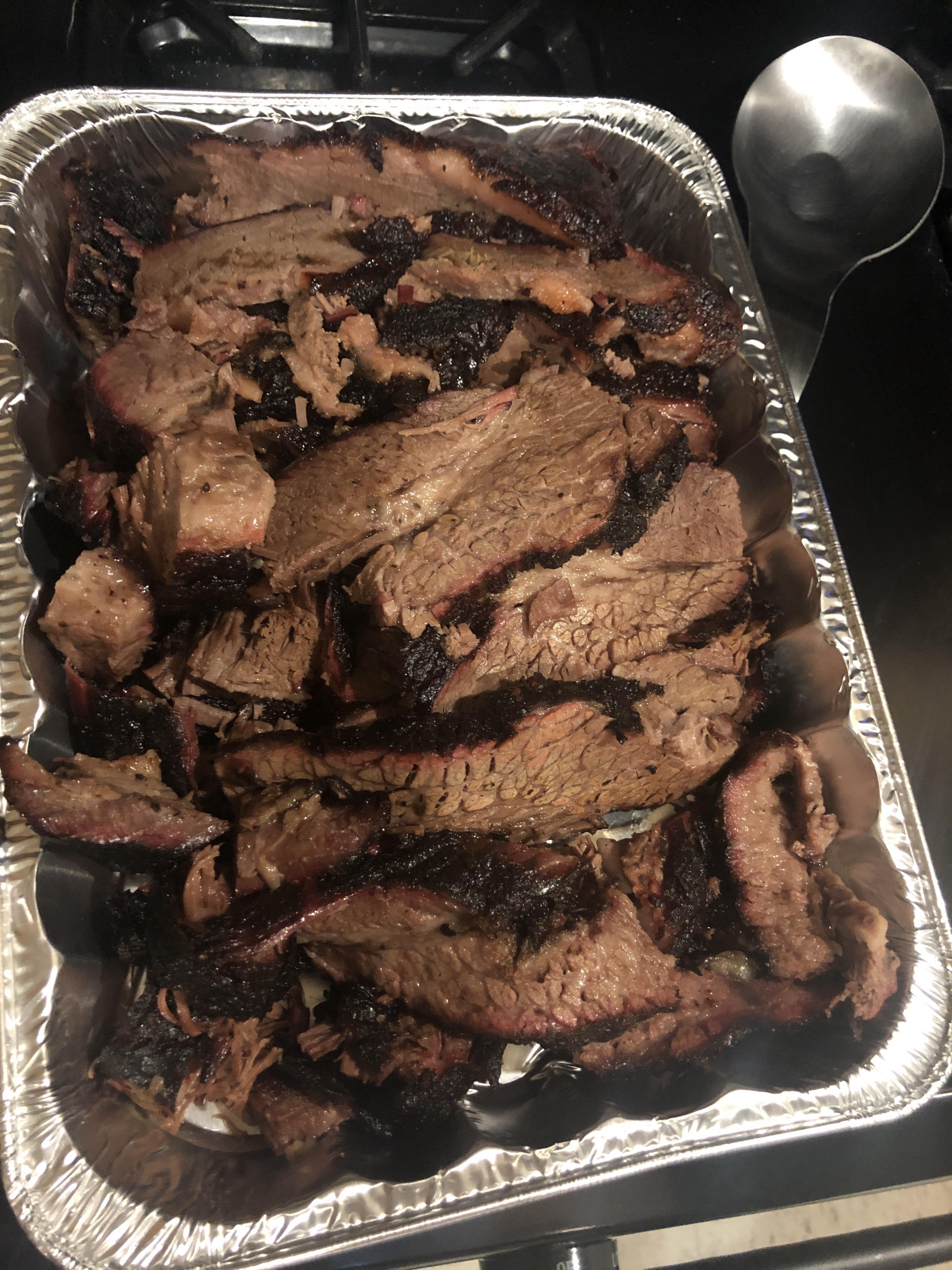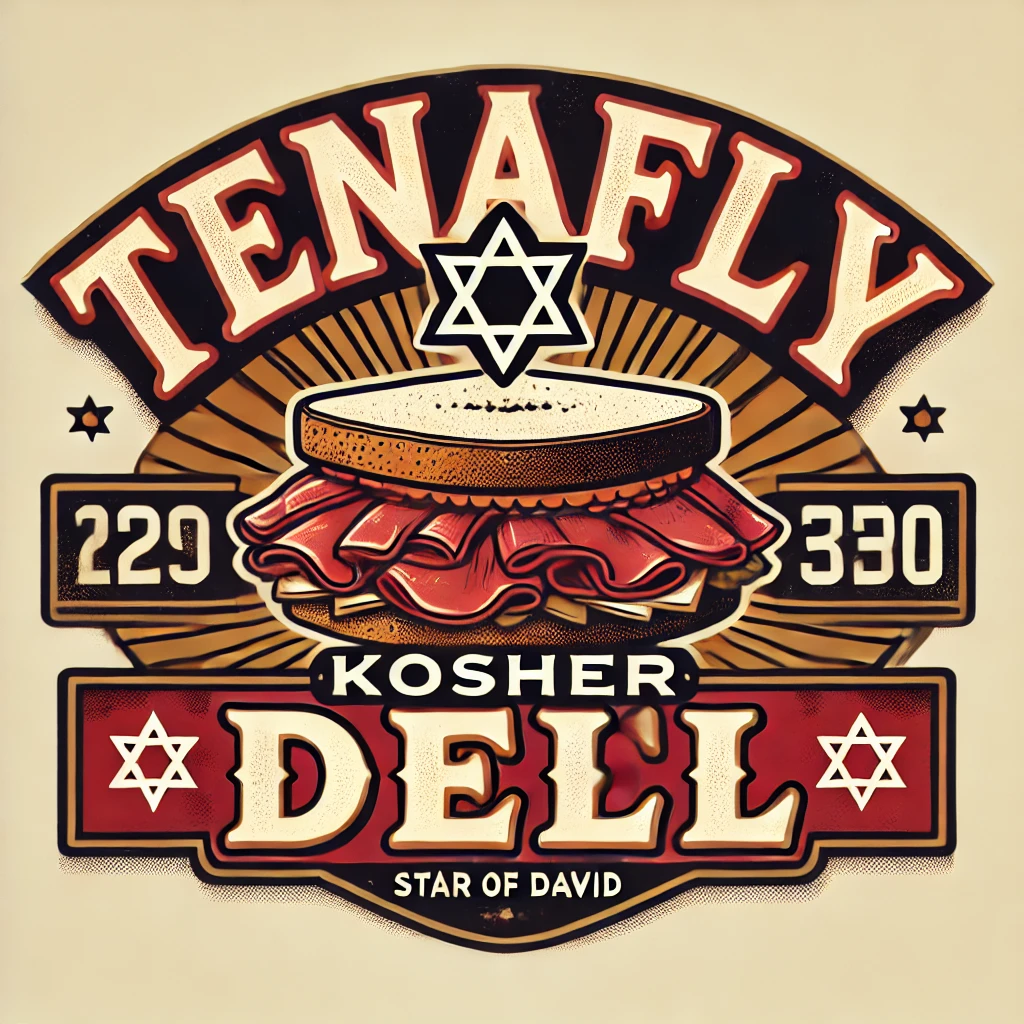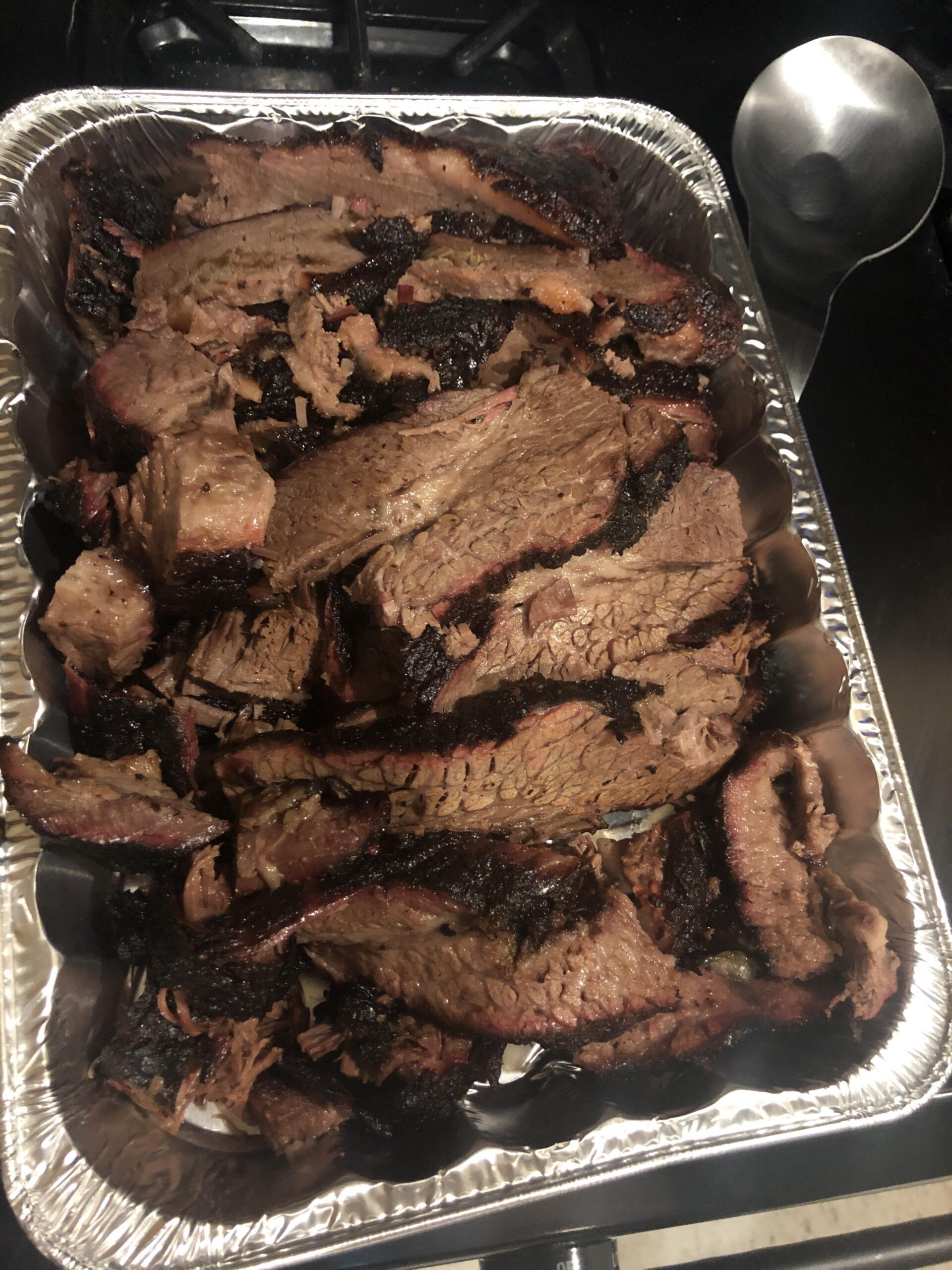
Brisket can definitely be overcooked, resulting in dry, stringy meat with diminished flavor. The perfect brisket reaches an internal temperature of 195-205°F and offers slight resistance when probed. To prevent overcooking, use a reliable meat thermometer, maintain a consistent temperature between 225-250°F, and allow proper resting time of at least one hour after cooking.
| Cooking Stage | Temperature | Tips | Signs of Overcooking |
|---|---|---|---|
| Initial Smoking | 225-250°F | Use hardwoods like oak or hickory | Tough, leathery exterior |
| Wrapping Point | Around 160°F internal | Wrap in butcher paper or foil | Meat too easy to pull apart |
| Finished Cooking | 195-205°F internal | Test with probe – should feel like butter | Dry, crumbly texture |
| Resting Period | Keep above 140°F | Rest for at least 1 hour | Loss of juiciness and flavor |
Introduction
What’s Brisket?
Brisket is a cut of beef from the chest area. It’s super popular with barbecue lovers and tends to pop up on menus in restaurants and homes that enjoy slow cooking. It’s known for its rich flavor and tenderness when cooked just right. This cut has a special spot in Texas barbecue, where it’s cooked low and slow for that melt-in-your-mouth goodness.
Why Cooking Brisket Right Matters
Cooking brisket might look simple but it’s got its share of challenges. Getting it right is key because:
- Flavor: A well-cooked brisket is juicy and smoky, really delightful for your taste buds.
- Tenderness: If it’s undercooked, it can be tough. But overcooked brisket? That’s usually dry and stringy.
- Looks: A perfectly cooked brisket looks great; it has nice bark on the outside and juicy slices on the inside.
Understanding how brisket works and the cooking methods helps you step up your barbecue game and impress your family and pals.

The Science of Cooking Brisket
Breaking Down Brisket
To really nail brisket, you’ve got to get to know its unique parts. It’s made up of two main muscles: the flat and the point.
- The Flat: This part is leaner and has less fat marbling than the point. It cooks faster, so you gotta keep an eye on it to make sure it doesn’t dry out.
- The Point: This part is fatty and has more connective tissues, which makes it more forgiving and gives you that juicy texture when cooked right.
This mix of fat and muscle is what makes brisket special. When you cook it low and slow, the collagen breaks down, turning tougher cuts into tender, flavorful bites.
Factors That Influence Brisket’s Texture and Taste
Several things can affect how your brisket turns out:
- Cooking Temp: Keeping a steady low temperature is key. Too high, and you’ll dry it out. Too low, and it might stall.
- Moisture Control: Wrapping it in butcher paper can help retain moisture while still developing a good bark.
- Letting It Rest: Allowing brisket to rest after cooking helps the juices distribute better, making it taste even better and juicier.
Knowing these things helps you get cooking techniques down pat and guarantees a tasty brisket each time.

Can Brisket Be Overcooked?
How to Tell If Your Brisket’s Overcooked
You bet, brisket can be overcooked. Here’s what to watch out for:
- Dryness: If the brisket feels tough or leathery, it’s a sure sign it’s overcooked.
- Stringy Texture: If it pulls apart too easily when sliced instead of holding its shape, it’s likely overcooked.
- Flavor: It loses that rich, smoky flavor and might taste burnt or bitter.
I remember once I served brisket that looked great but was completely off in texture—tough and not enjoyable for anyone. Total letdown for me and my guests.
How Overcooking Affects Taste and Texture
Overcooking affects not just the texture but the flavor as well:
- Less Juiciness: When overcooked, moisture goes away, leading to a dry bite.
- Flavor Changes: While a little concentration of flavor is good, too much can make it taste burnt and mask the meat’s natural richness.
- Bitter Flavors: Going too long can give it that burnt taste, ruining the smoky essence.
Being careful with time and temperature is essential to avoid these issues, making sure your brisket is both good-looking and delicious!

How to Keep Brisket From Being Overcooked
Tips for Cooking Brisket Right
To steer clear of overcooked brisket, pay attention to the details. Here are some tips:
- Use a Good Meat Thermometer: Get a reliable probe thermometer to keep an eye on the internal temp. Aim for around 195°F to 205°F for that perfect tenderness.
- Cook Low and Slow: Keep your cooking temperature steady between 225°F and 250°F. This method helps the collagen break down without drying the meat out.
- Start Fat Side Down: Cooking with the fat side down helps keep the brisket moist, giving you a juicier result.
From my experience, patience is key. The one time I rushed a brisket turned out to be a flop—it was dry and not satisfying.
Techniques to Keep Brisket from Overcooking
Try these techniques to prevent your brisket from getting overcooked:
- Wrap It Up: Once your brisket hits around 160°F after cooking for about five hours, wrap it in foil or butcher paper. This speeds up cooking and keeps moisture locked in.
- Let It Vent: After cooking, let the brisket rest by opening the foil for a bit before covering it again. This maintains moisture while cooling down.
- Check by Feel: Learn to gauge doneness by how it feels. A toothpick should slide in easily with little resistance.
Using these methods leads to a juicy, flavorful brisket that’ll impress everyone!

Different Ways to Cook Brisket
Smoking Brisket Like a Pro
Smoking brisket is the classic method that brings out all that flavor. The trick is managing the smoking environment and keeping a steady temperature. Here are some tips for perfecting your smoke:
- Choosing Your Wood: Use hardwoods like oak, hickory, or mesquite for a strong flavor. Trying different woods can create unique tastes.
- Get the Temp Right: Keep it between 225°F to 250°F. This low and slow method is what helps the collagen break down for a tender and juicy brisket.
- Wrap It: Once you reach about 160°F, consider wrapping it in butcher paper to keep moisture and speed up cooking.
I’ve smoked a bunch of briskets, and I’ll never forget nailing one after hours of patience—the crust was perfect, and my guests loved the juicy slices.
Oven Roasting for Great Results
If you don’t have a smoker, oven roasting can also yield some great results:
- Preheat: Set the oven to 225-250°F. Slow cooking in the oven ensures even heat.
- Seal in the Flavor: Start by searing the brisket in a hot pan to create a crust, then move it to the oven covered tightly with foil or in a roasting pan.
- Finish Off: Toward the end, uncover it to get a nice crust.
Whether you’re smoking or roasting, the journey to perfect brisket is all about getting familiar with the methods and tweaking them to enhance your skills. With practice, you’ll make something special every time!
Why Resting Brisket Matters
The Benefits of Resting Brisket
Letting brisket rest is super important for a tasty and juicy outcome. When you cook this big fatty cut, the heat pushes juices to the center. If you cut into it right away, those tasty juices will run out, making it dry. Here’s why resting is beneficial:
- Juice Redistribution: Resting lets the juices move back throughout the meat.
- Softens Up: Resting helps relax the connective tissue so each bite is tender.
- Better Flavor: Resting improves the overall taste by keeping those flavorful juices in.
I learned this the hard way when I rushed through the resting stage once and ended up with dry slices that bummed out my guests.
Resting Time and Best Practices
For brisket, resting for about an hour is recommended. Here are some best practices:
- Wrap It: After you take it out of the smoker, wrap it in foil to keep the heat in.
- Use a Cooler: Put the wrapped brisket in a dry cooler to keep its temperature without cooking it more.
- Watch the Temp: Make sure the resting brisket stays around 140°F before serving.
With this approach, your brisket will be juicy and ready to impress everyone!

Fixing Overcooked Brisket
How to Rescue Overcooked Brisket
If your brisket turns out overcooked, don’t worry; it can still be saved. Here are some ideas:
- Inject Some Moisture: If it’s dry, use a meat injector to add broth or a mix of apple juice and beef fat back into the meat.
- Sauces to the Rescue: Cover your brisket slices in tasty barbecue sauce to help hide the dryness and add flavor.
- Shredding and Moisture Bath: Shred the meat into pieces and toss it in a pot with beef broth to create a yummy filling for sandwiches or tacos.
One time at a BBQ, my brisket was tougher than I wanted, so I shredded it and mixed it with zesty sauce. No one even knew!
Fun Ways to Use Up Overcooked Brisket
If you end up with dry brisket, get creative:
- Brisket Quesadillas: Mix it with cheese and your favorite veggies in a tortilla for a tasty snack.
- Brisket Chili: Chop it up and toss it in chili for extra depth and flavor.
- Brisket Hash: Fry it up with potatoes and onions for a filling breakfast.
Thinking outside the box can turn a not-so-perfect brisket into a delicious meal everyone can enjoy!
Frequently Asked Questions About Cooking Brisket
How can you tell if brisket is overcooked?
Overcooked brisket typically has a dry, leathery texture, pulls apart too easily (becoming stringy rather than slicing cleanly), and may have a burnt or bitter taste. The meat will have lost much of its juiciness and might appear darker and more shrunken than properly cooked brisket.
What’s the ideal internal temperature for brisket?
The ideal internal temperature for perfectly cooked brisket is between 195°F and 205°F. At this temperature range, the collagen has properly broken down, making the meat tender but still moist. However, temperature alone isn’t a perfect indicator—the probe test (inserting a probe with minimal resistance) is also important.
How long should brisket rest after cooking?
Brisket should rest for at least 1 hour after cooking, though 2-4 hours is often better for larger cuts. This allows juices to redistribute throughout the meat. Wrap it in foil and towels, then place in a cooler (without ice) to maintain temperature without continuing to cook the meat.
Can you save an overcooked brisket?
Yes, overcooked brisket can be salvaged. Methods include: injecting it with beef broth, chopping and mixing with barbecue sauce, shredding for tacos or sandwiches, or incorporating it into chili, stews, or hash. While the original texture is compromised, these methods can still create delicious meals.
Is it better to smoke or oven-roast brisket?
Smoking brisket provides a distinctive smoky flavor that many BBQ enthusiasts prefer, while oven-roasting offers more consistent temperature control and convenience. Both methods can produce excellent results if done properly. Smoking excels for authentic BBQ flavor, while oven-roasting is great for those without a smoker or in inclement weather.
What’s the best way to slice brisket?
Always slice brisket against the grain to shorten the muscle fibers, resulting in more tender bites. For the flat portion, this means slicing perpendicular to the visible grain lines. For the point section, you may need to rotate the meat 90 degrees as the grain direction changes. Aim for pencil-thickness slices (about 1/4 inch).
In Summary
Recap of Risks with Overcooking
As we explore brisket, understanding the risks of overcooking is super important. Dry brisket usually signals overcooking, but there’s also improper seasoning and low fat that can ruin it. Remember these points:
- Keep an Eye on Temperature: Letting your cooking temp fluctuate can lead to overcooked briskets. Don’t let it sit in the oven too long, as that can go beyond the tender zone.
- Know Your Doneness: Just checking the temp alone can be tricky. The probe test for tenderness is a better way to check if your brisket is ready to roll.
Having faced these issues myself, I’ve seen that being attentive while cooking makes a world of difference.
Final Thoughts on Perfecting Brisket
Getting brisket just right is an art, and patience is your best friend. Balancing flavor and texture takes practice and a willingness to adapt. Here are some last thoughts:
- Try New Techniques: Don’t hesitate to experiment with different methods—smoking, wrapping, and resting all add something different to the mix.
- Learn from Mistakes: Each cooking experience offers lessons, so embrace it all, even when things don’t go the way you hoped.
Ultimately, mastering brisket is about understanding the meat and honing your skills over time for the best results!

A Bergen County institution celebrating authentic Jewish cuisine since 1985. Our pastrami—brined for 14 days, smoked over applewood for 12 hours, and steamed to perfection—creates a melt-in-your-mouth experience that rivals Manhattan’s finest delis. Our rye bread is baked fresh daily using a century-old recipe from Poland. Featured in Food & Wine’s “Top 10 Delicatessens in America” and on Food Network’s “Best Thing I Ever Ate.” Chef Moshe Greenbaum, a third-generation deli master trained at the Culinary Institute of America, ensures every sandwich meets our exacting standards. No wonder our customers drive from three states away.

Leave a Reply